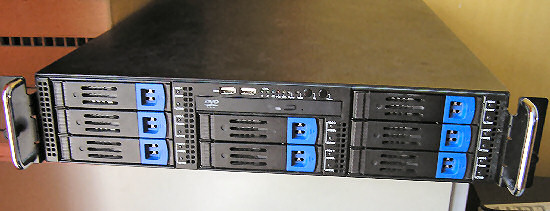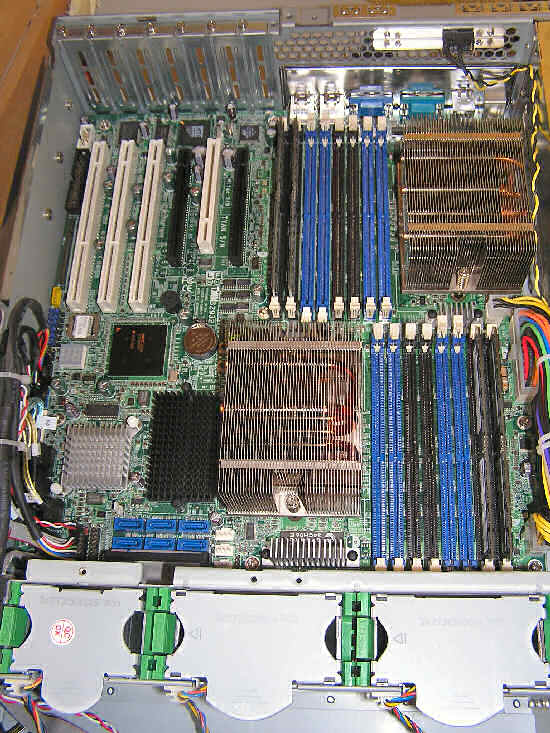Tyan Transport TA26
It has taken us a while, but we finally have a full blown Socket F server in the labs.

The Tyan TA26's front
The 2U rack-mountable barebone TA26 B2932 supports two Socket F Opterons and didn't have any trouble with our Opteron 3.2GHz parts. (The BIOS was flashed to version 2.0). The exact model in the lab is the B2932T26W8HR which supports eight hot swappable SAS disks and a (1+1) redundant 600W power supply.

The internals of our Tyan Server
The motherboard in the system is the TYAN Thunder n3600M S2932, which is based on the NVIDIA nForce Pro 3600. A total of sixteen DDR2 DIMM sockets support up to 64GB of registered DDR2-667 memory. Two PCI Express x16 slots (x8 electrical) allow interested sysops to turn this server into an SLI gaming machine, but you'll need 2U GeForce cards.... (We are kidding, of course.) It is good to see that there are still two PCI-X 133/100MHz, one PCI-X 100MHz, and one 32-bit PCI slot available as this will protect any previous investments in NICs and storage adapters.
Our experiences were very good with this server: removable components such as fans, heatsinks, disks, and PSUs are very user-friendly and easy to use. We saw only one minor disadvantage: the three fast fans are capable of cooling the 3.2GHz chips, but when one fails the cooling system hits its limits. We didn't experience any crashes, but the CPUs got very hot (70-75°C) with two fans. On the plus side, the automatic fan speed control does a very good job in adjusting fan speed to provide sufficient heat dissipation. There is very little latency: the fan speed almost immediately increases as the CPU throttles up from being idle at 1GHz to full load at 3.2GHz.
It has taken us a while, but we finally have a full blown Socket F server in the labs.

The Tyan TA26's front
The 2U rack-mountable barebone TA26 B2932 supports two Socket F Opterons and didn't have any trouble with our Opteron 3.2GHz parts. (The BIOS was flashed to version 2.0). The exact model in the lab is the B2932T26W8HR which supports eight hot swappable SAS disks and a (1+1) redundant 600W power supply.

The internals of our Tyan Server
The motherboard in the system is the TYAN Thunder n3600M S2932, which is based on the NVIDIA nForce Pro 3600. A total of sixteen DDR2 DIMM sockets support up to 64GB of registered DDR2-667 memory. Two PCI Express x16 slots (x8 electrical) allow interested sysops to turn this server into an SLI gaming machine, but you'll need 2U GeForce cards.... (We are kidding, of course.) It is good to see that there are still two PCI-X 133/100MHz, one PCI-X 100MHz, and one 32-bit PCI slot available as this will protect any previous investments in NICs and storage adapters.
Our experiences were very good with this server: removable components such as fans, heatsinks, disks, and PSUs are very user-friendly and easy to use. We saw only one minor disadvantage: the three fast fans are capable of cooling the 3.2GHz chips, but when one fails the cooling system hits its limits. We didn't experience any crashes, but the CPUs got very hot (70-75°C) with two fans. On the plus side, the automatic fan speed control does a very good job in adjusting fan speed to provide sufficient heat dissipation. There is very little latency: the fan speed almost immediately increases as the CPU throttles up from being idle at 1GHz to full load at 3.2GHz.










30 Comments
View All Comments
piroroadkill - Tuesday, August 7, 2007 - link
it is a car analogyGul Westfale - Monday, August 6, 2007 - link
good analogy there, except that mustangs (and various other cars) use pickup truck engines for cost reasons. large trucks use larger engines (often diesels) because they offer considerably more torque at much lower RPM than a smaller gasoline engine; and thus provide more pulling power.Gul Westfale - Monday, August 6, 2007 - link
these are not regular consumer cpus, but intended for use in commercial servers and workstations. they and their motherboards cost more because they support features such as multiple sockets (so in addition to having multiple cores on one chip you can also have multiple chips on one motherboard).yyrkoon - Monday, August 6, 2007 - link
they win 1 of 2 tests, and it is clear they are the winner ? Why ? Because they won the software rendering also ? Anyone interrested enough in rendering, and HAVING to have this sort of hardware for it is NOT going to bother with software . . .
This means your conclusion on this point is incorrect, and in which case, it boils down to which application the rendering machine is going to do.
Man you guys come to the wierdest conclusions based on your own data, and I am not even the first to notice/mention this sort of thing . . .
JohanAnandtech - Monday, August 6, 2007 - link
The Quadcore wins all high resolution rendering tests. Where do you see the DC opterons win against the Quadcore Intel in high resolution rendering? Show me a rendering engine where a 3 GHz K8 DC core is faster in high resolution renderering than a 2.33 GHz Quadcore. All decent and used in the realworld rendering engines will more or less show the same picture.In fact, the "rendering performance" situation will get worse for the K8 as SSE-2 tuning will get more common. All Intel CPUs since core and all AMD CPUs since Barcelona will show (or are already showing) high performance boost from using better SSE-2 code.
yyrkoon - Monday, August 6, 2007 - link
Ok, I see now with the graphs 'lower is better' on 3ds max, I missed that with the tables, which is actually what I meant this morning 'table obfustication'. I personally do not mind tables, but when the data is not in a uniform spot, it confuses/makes it harder to read at a glance.Anyhow, I was tired when I posted this morning, cranky, and was overly harsh I think. However it *is* much easier for me personaly to read the graphs at a glance (I cannot speak for everyone though).
yyrkoon - Monday, August 6, 2007 - link
Oh, and while on the subject, you guys here at anandtech have lately mastered the art of graph obfustication. Is it really THAT hard leaving items in the same rows / columns for different tests ? Are we trying to confuse the results, or is there some other reason this happens, and has gone completely over my head ?JohanAnandtech - Monday, August 6, 2007 - link
The only reason is that until very recently I didn't master the graphing engine. I got some weird error messages and gave up. But I have found the error, and you should see some nice graphs which don't obfusticate...Spoelie - Monday, August 6, 2007 - link
the gif on page 2 is non-looping, so after a very quick jump from 1ghz -> 2.8ghz (why??) -> 3.2ghz , it stays put on the 3.2ghz image. If reading the article, by the time the reader sees the image, it's already 5 minutes on the last image and staying there, making it for all intents and purposes a static image instead of an animated one:)
JohanAnandtech - Monday, August 6, 2007 - link
Thanks, fixed that. The reason to show 2.8 GHz is that for example Specjbb and other applications sometimes don't completely stress the CPU and then the cpu dynamically goes back to 2.8 GHz. It are simply the 3 stages I saw the most, and found the most interesting to show.